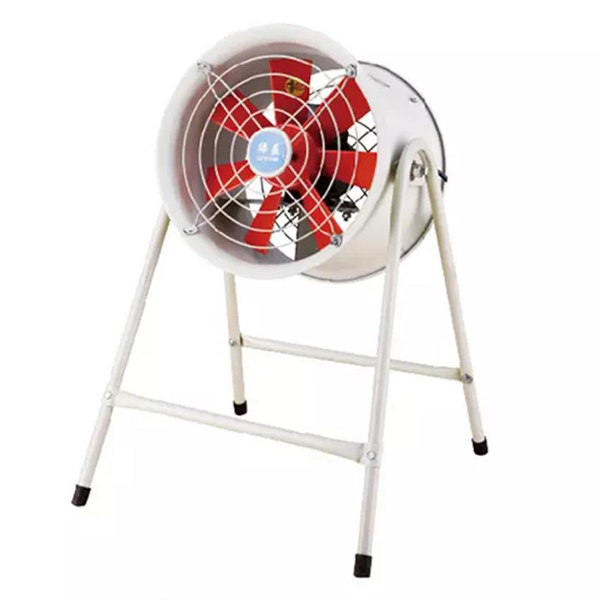The working principle of cylindrical blower
The working principle of centrifugal blower is similar to that of centrifugal ventilator, but the compression process of air is usually carried out through several working impellers (or several levels of )under the action of centrifugal force. The blower has a rotor that rotates at a high speed. The blades on the rotor drive the air to move at a high speed. The centrifugal force makes the air flow to the outlet of the fan along the involute line in the casing with the shape of the involute. Fresh air is replenished by entering the center of the housing.
Working principle of single stage high speed centrifugal fan is: engine by high speed rotation shaft to drive the impeller, axial airflow by imports after entering the high-speed rotating impeller into radial flow is accelerated, and then into the cavity expansion pressure, change flow direction and reduction, the reduction effect will be in the high speed rotating airflow with kinetic energy into pressure energy (potential energy), make the fan exports stable pressure.

Theoretically speaking, the pressure-flow characteristic curve of centrifugal blower is a straight line, but due to the friction resistance and other losses inside the fan, the actual pressure and flow characteristic curve gently decreases with the increase of the flow, and the corresponding power-flow curve of centrifugal fan rises with the increase of the flow. When the fan is running at a constant speed, the working point of the fan will move along the pressure-flow characteristic curve. The operating point of the fan depends not only on its own performance, but also on the characteristics of the system. When the resistance of the pipe network increases, the pipe performance curve will become steeper.
The basic principle of fan regulation is to obtain the required working conditions by changing the performance curve of the fan itself or the characteristic curve of external pipe network.With the continuous development of science and technology, AC motor speed regulation technology is widely used. Through the new generation of fully controlled electronic components, the flow of the fan can be controlled by changing the speed of the AC motor with the frequency converter, which can greatly reduce the energy loss caused by the previous mechanical mode of flow control.
Energy saving principle of frequency conversion regulation:
When the air volume needs to be reduced from Q1 to Q2, if the throttle regulation method is adopted, the working point changes from A to B, the wind pressure increases to H2, and the shaft power P2 decreases, but not too much. If the frequency conversion regulation is adopted, the working point of the fan is from A to C. It can be seen that under the condition that the same air volume Q2 is satisfied, the wind pressure H3 will greatly decrease and the power will be reduced
P3 was significantly reduced. The power loss saved △P=△ Hq2 is proportional to the area BH2H3c. From the above analysis, we can know that frequency conversion regulation is an efficient way of regulation. The blower adopts frequency conversion regulation, will not produce additional pressure loss, energy saving effect is remarkable, adjust the air volume range of 0%~ ~ ~100%, suitable for a wide range of regulation, and often under low load operation occasions. However, when the speed of the fan decreases and the air volume decreases, the wind pressure will change greatly. The proportional law of the fan is as follows :Q1/Q2=(N1 / N2), H1/H2=(N1 / N2)2,P1/P2=(N1 / N2)3
It can be seen that when the speed is reduced to half of the original rated speed, the flow rate, pressure and shaft power of the corresponding working condition point drop to 1/2, 1/4 and 1/8 of the original, which is the reason why the frequency conversion regulation can greatly save electricity. According to the characteristics of frequency conversion regulation, in the sewage treatment process, the aeration tank always keeps the normal liquid level of 5m, and the blower is required to conduct a wide range of flow regulation under the condition of constant outlet pressure. When the adjustment depth is large, the wind pressure will drop too much, which can not meet the process requirements. When the adjustment depth is small, it can not show the advantages of energy saving, but make the device complex, one-time investment increased. Therefore, under the condition that the aeration tank of this project needs to keep the liquid level of 5m, it is obviously inappropriate to adopt frequency conversion regulation mode.
The inlet guide vane regulating device is equipped with a set of adjustable Angle guide vane and inlet guide vane near the suction inlet of the blower. Its role is to make the air flow rotate before entering the impeller, causing the twisting speed. The guide blade can be rotated around its own axis. Each rotation Angle of the blade means the transformation of a guide blade installation Angle, so that the direction of the air flow into the fan impeller changes accordingly.
When the guide blade installation Angle 0=0°, the guide blade basically has no effect on the inlet airflow, and the airflow will flow into the impeller blade in a radial way. When 0 BBB 0°, the inlet guide vane will make the absolute velocity of the airflow inlet deflect О Angle along the direction of the circumferential velocity, and at the same time, it has a certain throttling effect on the velocity of the airflow inlet. This pre-rotation and throttling effect will lead to the decline of the fan performance curve, so as to change the operating conditions, and realize the fan flow regulation. Energy saving principle of inlet guide vane regulation.
Comparison of different modes of regulation
Although the frequency conversion adjustment of centrifugal blower adjustment range is very wide, have a significant effect on energy saving, but with process system is limited by process conditions, the adjusting range is only 80% ~ 100%, the relative flow rate changed little, frequency conversion adjustment methods and guide vane two consumed power difference is not large, so the inverter control mode, the energy saving special show not to come out, it loses the choice its meaning. The blower with the guide vane regulation mode can adjust the air volume (50%~ 100%) in a larger range under the condition of keeping the outlet pressure constant, so as to ensure the stable content of dissolved oxygen in the sewage and save energy relatively. Therefore, the high-speed centrifugal fan with guide vane regulation mode should be selected as the equipment selection in this project. At the same time, in order to better reflect the energy saving effect, for high-power centrifugal fan, attention should also be paid to the choice of supporting motor, such as the use of 10kV high voltage motor, also help to reduce energy consumption.
Post time: Apr-09-2021
